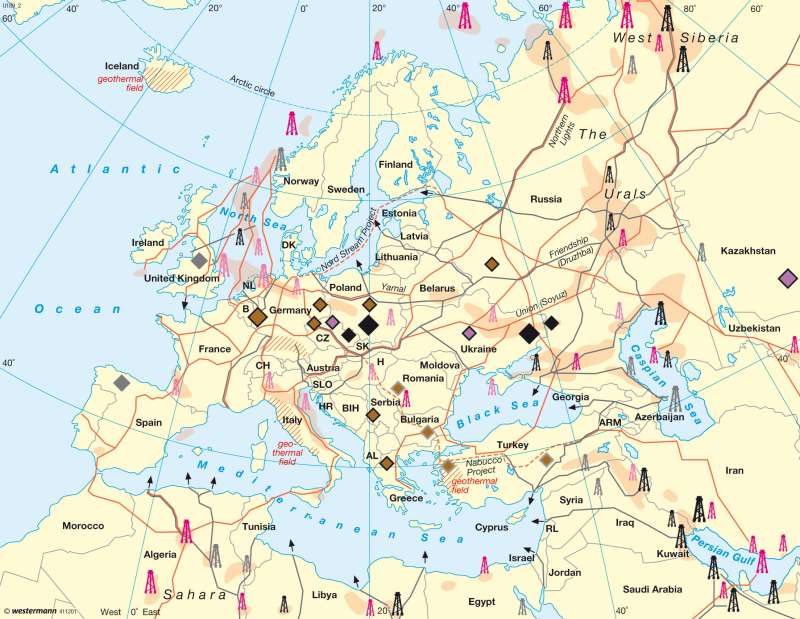Energy resources
Europe - Energy
978-3-14-100790-9 | Page 48 | Ill. 1

Information
The map shows the occurrence of fossil raw materials oil, gas, coal, lignite, and uranium in Europe. These reserves are classified according to their size and their global importance. In addition, the main oil and gas pipelines, as well as the ports from which oil and gas are shipped, are marked.Oil and Gas
Oil and gas are not only used as an energy source but also as an important raw material in the chemical industry. Oil is only extracted in small quantities in Europe, in the North Sea and west of the Urals. Larger, more globally significant oil reserves are located in Northern Africa, the Persian Gulf, Caspian Sea and in Siberia. There are significant gas reserves offshore in the North Sea and the Norwegian Sea, onshore north of Russia, the Red Sea and North Africa. Small gas fields occur in northern Germany, western France, northern Italy, Romania, Hungary, Poland, Ukraine and the European part of Russia. The oil and gas resources on the Volga and the Urals, the Caspian Sea and Siberia are linked by pipelines to customers in Europe. The great dependence on these imports was significant in 2006 and 2009, as a gas dispute between Russia and neighbouring Ukraine interrupted the supply of Russian gas to Europe. Other oil and gas imports on European tankers at ports in southern and eastern Mediterranean have been replaced with the oil and gas loaded from North Africa and the Middle East.
Coal, lignite and uranium
Major coal reserves now lie in the Upper Silesian industrial region in Poland and in the Donets Basin in Ukraine. Today, the coalfields in the Ruhr area, in central England and northern Spain have reduced to small coal reserves. However, these coal deposits have formed the precondition for the emergence of entire industrial areas. Since the coal crisis of the 1950's, a profound structural change has taken place in these areas. Thus, today, more than half of all workers in the Ruhr are in the service sector. The lignite deposits of the Rhine lignite mining area are still of great importance. Other coal deposits exist in the Central German and Lusatian areas, Poland, Serbia and Greece and western Russia. Significant uranium reserves are located in the Czech Republic and Ukraine with less significant presence in Romania, Bulgaria and Turkey.
Worldwide importance of European reserves
Of the total 39,100 Exa-joule (EJ), the 2007 worldwide reserves of non-renewable energy resources which were available, accounted for only 4.5 percent (1,746 EJ) in Europe. The largest share fell to lignite, which is 614 EJ, with almost one fifth of the world's coal reserves. The European share of world coal reserves amounted in contrast, to only 2.9 percent. Europe provided 3.2 percent of gas and 1.5 percent of oil global reserves.
H. Kiegel; Ü: C. Fleming




